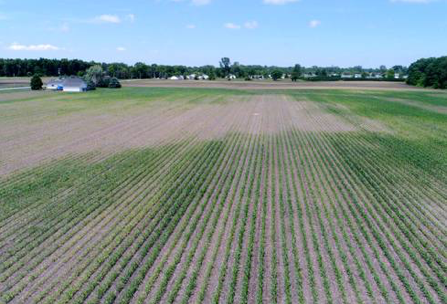Exactly a month ago, I wrote a Michigan State University Extension article about grubs that included a handy field identification sheet for grubs to assist in identifying different species, says Christina DiFonzo. It’s time to pull out that sheet if you are in the Mich., Ind. and Ohio region.
Planting in the region was delayed in many locations due to cold, then extremely wet conditions, says the Michigan State University entomologist. Crummy stands were being attributed to standing water, weed competition or herbicide injury.
But if the stand is poor on the top of a rise in the field (i.e., an area that did not have standing water) or in locations you know have sandy soil, take another look.
In the region, Asiatic garden beetle damage is now very apparent from the road, evident as bare ground, thin stands, stunted plants, variable height or yellowing (see more Asiatic garden beetle damage pictures).

Aerial view of a field in Monroe County, Mich. showing thin stand and yellowing (the thin, yellow areas are a replant). There were an average of two grubs per cup cutter, but hot spots with six to seven per cutter. Pupae were found this week. Photo by Ricardo Costa, MSU Extension.
However, I confirmed several damaged soybean fields in northern Indiana. I have visited fields from Decatur, Michigan, in Van Buren County, east to Dundee, Michigan, in Monroe County, and my lab is following several fields on a weekly basis.
What we learned so far:
- Favored weeds infested by Asiatic garden beetle grubs so far include marestail, purple deadnettle, chickweed, pokeweed and Virginia creeper.
- In weedy fields, grubs seem to remain on the weeds persistently, even after the corn is planted. Why move from a delicious weed to a new plant? In other words, the silver lining to poor weed control is that weeds keep many grubs away from the corn. When herbicide is finally applied, the grubs move on to the corn and damage can occur seemingly overnight. This is similar to what happens with black cutworm after a herbicide application.
- Asiatic garden beetle grubs appear to drown in saturated soil or at least pop up on the soil surface, where they can be killed by something else. In other words, the silver lining to standing water is Asiatic garden beetle control.
- There are no insecticide control options that stand out. So far I’ve seen grubs surviving low, medium and high (250-500-1250) rates of seed treatment, Lorsban and tillage.
- This week, we found the first pupae (as did cooperators from Ohio State University sampling in northwest Ohio). That means the oldest grubs are in the process of transforming into adult beetles, so they will no longer feed and cause damage. We do not know, however, how long it takes for all the grubs in a heavily infested field to complete this process, releasing the corn from feeding stress. This is a question we are trying to answer by sampling grubs weekly and trapping the emerging adults.
Many people are experiencing this insect for the first time as populations slowly push northward.
I don’t have many answers, but I am cooperating with the field crops entomology program at Ohio State University to pool data and get a better understanding of the life cycle and damage period for this vicious little insect.
In the fall, we will be looking for infested locations to sample next spring, so keep the locations of bad fields in mind or report them to me at difonzo@msu.edu.






Post a comment
Report Abusive Comment